Spells for Justice
It’s the last day of Crime and Punishment week here at Necromancers of the Northwest, and so it’s naturally time to lay down the law with some justice-related spells. So, those of you who’ve always wanted to see what the inside of a magical prison looks like, here’s something of a hint.
Agony Bolt
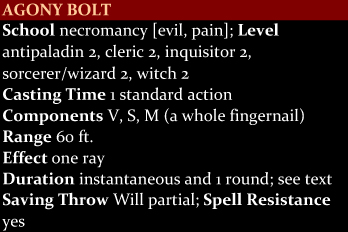
You fire a ray of pulsing red and black energy which bores into the target, causing extremely debilitating pain. Treat this as a ranged touch attack. If the attack hits, the target suffers 2d6 points of damage, and must succeed on a Will save at a -2 penalty. If he fails, he suffers a -2 penalty on Will saves for one round, as his will to resist is subsumed by agonizing pain.
Detention Sphere
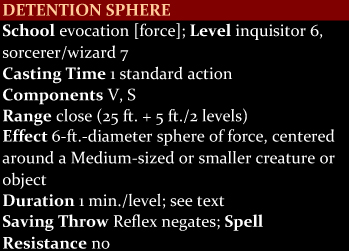
You surround the target in a shimmering globe of force energy. This functions as the spell resilient sphere, except as noted here. First, the sphere is not immobile: while the creature inside the sphere is unable to move it, those outside it can push or drag it as normal (the sphere itself weighs nothing, but the weight of anyone or anything inside the sphere remains the same). As with telekinetic sphere, the sphere falls at a rate of only 60 feet per round, which is not enough to cause fall damage to anything inside the sphere. Also, any attempt to leave the sphere through extradimensional travel (including spells like dimension door, teleport, plane shift, ethereal jaunt, and similar spells) are blocked by a phenomenon similar to spell resistance. In order to use such a method of escape, the caster must succeed on a caster level check (1d20 + caster level + any bonuses that apply to overcoming spell resistance) with a DC equal to 10 + your caster level + your primary spellcasting ability score modifier.
Additionally, you can extend the spell by spending a full round action and sacrificing a prepared spell or unused spell slot at any time during the spell’s duration. If you do so, the spell’s duration is extended by 1 hour per level of the spell you sacrifice (so if you sacrifice a 3rd-level spell it will be extended by 3 hours, and if you sacrifice a 5th-level spell it will be extended by 5 hours, etc.).
Enforced Docility
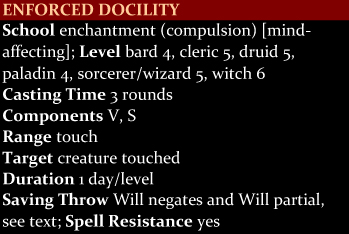
The target’s mind is filled with an intense dislike for the idea of harming anything. When you initially cast the spell, the target is allowed a Will save to resist. If he succeeds, he is not affected by the spell at all. Otherwise, for the spell’s duration, any time the target would make a violent action (such as attacking a creature, casting a spell that deals damage or allows a saving throw that is not denoted as “harmless,” or another action that will directly result in damage or death to another living creature), he must succeed on a Will save or be unable to perform that action. Further, even if he succeeds on the Will save, the very act of violence is enough to make him physically ill: as soon as he performs the action, he is nauseated for 1d4 rounds, and then sickened for 1d4 minutes after that.
Spell Seal
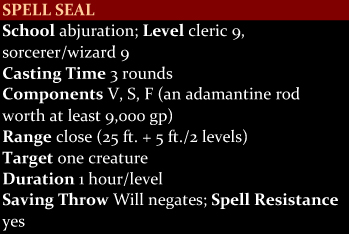
You magically block the target from being able to access the source of his or her magic, making it impossible to cast spells. For the spell’s duration, the target is unable to cast spells or use spell-like or supernatural abilities. He may still activate spell-trigger and spell-completion items, such as wands, scrolls, and staves, and he retains access to his extraordinary abilities, if any.
Well, that’s it for this week. Hope you enjoyed the…huh? What’s that? You want another spell? You’re so excited for our upcoming Advanced Arcana III, which is packed with over 100 awesome new spells, using exciting new spell mechanics like opportune spells, arcane wells, and ascension spells, each of which let you do things with magic that you never thought possible in Pathfinder that you don’t want to wait until Monday for new spells (at the low, low price of $9.99, I might add, and that includes the appendices with new sorcerer bloodlines, a completely new and far more robust way to look at witch patrons, and over a dozen exciting variants on potions, scrolls, and wands)? Well, fine. I guess I can give you a bit of a preview.
Since it is Crime and Punishment week, let me start with a crime-and-punishment related spell, cast in chains.
Cast in Chains
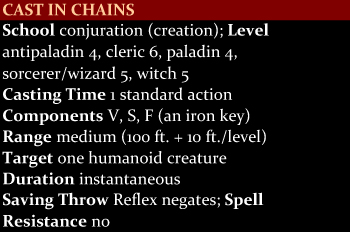
You create a set of masterwork manacles, which bind the target hand and foot. If the spell is successful, the target is rendered helpless and unable to move. As with any other manacles, the target can use Escape Artist to try to break free (DC 35 for masterwork manacles), or attempt to burst them with a Strength check (DC 28 for masterwork manacles). The manacles are made with superior locks (DC 40 Disable Device check to open).
Other than the way that they were created, the manacles are completely mundane in nature, and remain indefinitely. They do not radiate a magical aura or have any special abilities. The lock on the manacles is designed to be opened by the key used as a focus for the spell.
If the target succeeds on his saving throw, the conjured manacles appear harmlessly on the ground at his feet.
While cast in chains is fun, and something I’ve always thought that powerful spellcasters should be able to do, and thematically appropriate, it’s not exactly the most exciting preview for Advanced Arcana III, so I’m going to go ahead and give you another freebie.
Sorvithal’s Blackest Curse
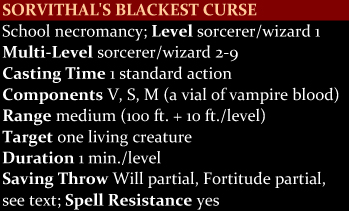
With a word, you surround your target in a vortex of dark energies, which suffuse his skin and vanish into him, marking him with a terrible curse. This spell has additional effects that occur if it is prepared in a higher-level spell slot than normal. The information below lists the effect that the spell has for each level it can be prepared in. If prepared in a given level, the spell has the effect listed for that level, plus every lower-level effect listed, as well. Metamagic feats, and other effects which increase the level of spell slot that a spell takes up, do not count for this purpose. For more information on how multi-level spells work, see the Spell Rules section, at the beginning of this book.
1st—The target is overwhelmed with feelings of dread and despair: unless he succeeds on a Will save, he suffers a -2 morale penalty on attack rolls, damage rolls, skill checks, and ability checks for the spell’s duration. The effect associated with this level of the spell is treated as having the mind-affecting and fear descriptors.
2nd—The curse drains the target’s Strength, inflicting 1d3 points of Strength damage unless he succeeds on a Fortitude save.
3rd—Foul necromantic energies suffuse the target, preventing the restoration of his body. For the duration of the spell, the target cannot heal ability score damage naturally, and any attempt to restore it magically fails unless the caster succeeds on a caster level check (DC 11 + your caster level).
4th—The curse slows the target’s reflexes and makes him sluggish, inflicting 1d3 points of Dexterity damage unless he succeeds on a Fortitude save. This is the same Fortitude save as the one made to resist the effects of the 2nd-level version of the spell, so if the target successfully resists Strength damage, he also resists Dexterity damage, and vice versa.
5th—The curse suffuses the target with dark energies that interfere with healing of all kinds. For the duration of the spell, the target cannot recover hit points naturally, and any magical healing he receives restores only half as many hit points as it normally would.
6th—The energies of the curse are sufficient to reanimate the target should he die while under its effects. If the target dies while under the effect of the spell, he immediately rises as a wight. The wight retains the target’s memories, but none of his allegiances: the wight’s starting attitude is indifferent towards you and hostile towards all other living creatures. It can be controlled through the normal means of controlling undead. Unlike most wights, those created by this spell cannot create spawn.
7th—The curse wraps the target in ill luck and oppressive energy, and for the duration of the spell, he suffers a -2 penalty on all saving throws.
8th—The curse latches onto the target’s soul, capturing and devouring it in the event that the target is slain. If the target dies while the spell is in effect, its soul is destroyed, and it cannot be resurrected by any means unless a wish or miracle spell is used to restore the soul from oblivion. This does not prevent the target from rising as a wight.
9th—The curse slowly but surely sucks the life from the target. He suffers 2d6 points of negative energy damage each minute for as long as the curse remains in effect.
You may notice that Sorvithal’s blackest curse is a little different from most spells, mostly in that it has a different effect depending on the spell level at which it is cast. Advanced Arcana has a number of these spells, known as ascension spells, and let me tell you, they’re a blast. If you want to see more of them, or want more details on how they work, be sure to pick up a copy of Advanced Arcana III this Monday. And if you’re still not convinced that Advanced Arcana III is the best thing that ever happened to magic, be sure to come back this time next week, and we’ll show you a little bit more of the next big thing in spellcasting.


